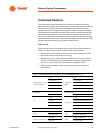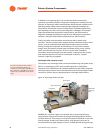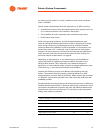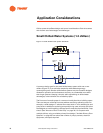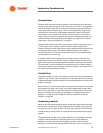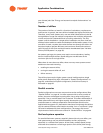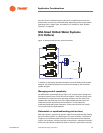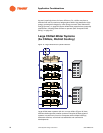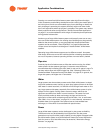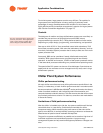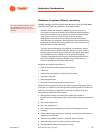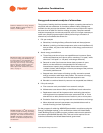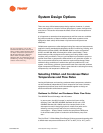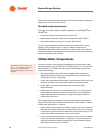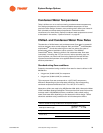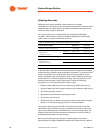
Application Considerations
SYS-APM001-EN Chiller System Design and Control 23
Creating one centralized chilled-water system takes significant foresight,
initial investment, and building development with a multi-year master plan. If
the initial plant is built to accommodate many future buildings or loads, the
early challenge is operating the system efficiently with much lower loads
than it will experience when the project is complete. The system may need to
blend parallel and series configurations (“Series–Counterflow Application”
on page 77) to accommodate the wide range of loads the plant experiences
during phased construction.
Another type of large chilled-water system could actually start out as more
than one chilled water-system. An existing set of buildings can be gradually
added to the central system, or two geographically distant chilled-water
systems can be connected. “Plant Expansion” on page 83 discusses the
unique control and hydraulic challenges of “double-ended” chilled-water
systems.
Operating large chilled-water systems can be different as well. As system
load drops, chillers are turned off. Individual chiller unloading characteristics
are not as important, because operating chillers are more heavily loaded.
Pipe size
Practical pipe size limitations start to affect the maximum size of a chilled-
water system. As the systems get larger, it becomes more difficult to
accommodate the increasing pipe sizes, both in cost and in space. Large Ts
can help reduce flow and required pipe size. (See “Selecting Chilled- and
Condenser-Water Temperatures and Flow Rates” on page 27.) In general, the
larger the system, the higher the T should be.
Water
Large systems are almost always water-cooled. Both chilled water (a closed
loop) and condenser water (usually an open loop) pipes will have to be filled
with water. In some locations, it is difficult to find enough fresh water to fill a
very large system with water, especially if the chilled-water system is quite
distant from the loads. Cooling towers consume water, which can be
significant and difficult to obtain in some locations. The search for both
locally available make-up water and energy savings can lead to the
exploration of alternative condensing sources like lake, river, or well water.
(See “Well, river, or lake water” on page 72.) In rare instances, salt water or
brackish water can be applied if the system uses an intermediate heat
exchanger, or if the chiller is constructed with special tubes.
Power
Large chilled-water systems can be challenged by site power availability.
Transformer size may be dictated by local regulations. On-site power
generation may be part of the project, leading to using higher voltages inside
the chilled-water system to avoid transformer losses and costs. Alternative
fuels for some or all of the chillers may be attractive (“Alternative Energy
Sources” on page 82).



